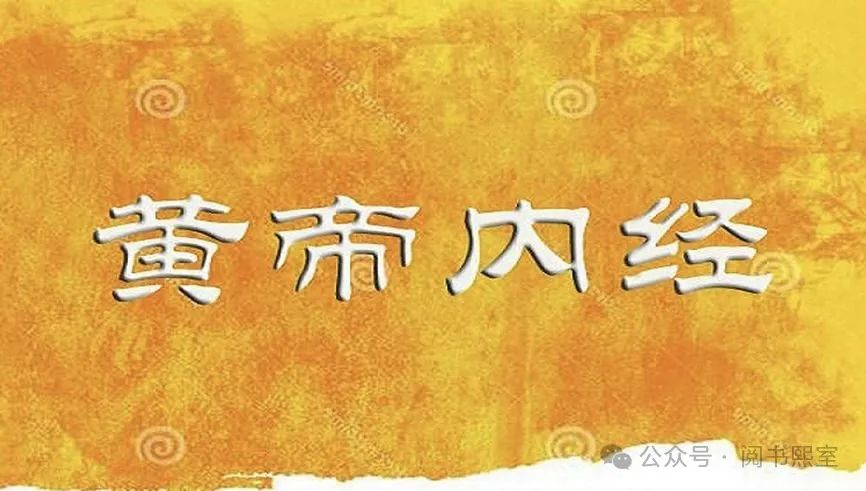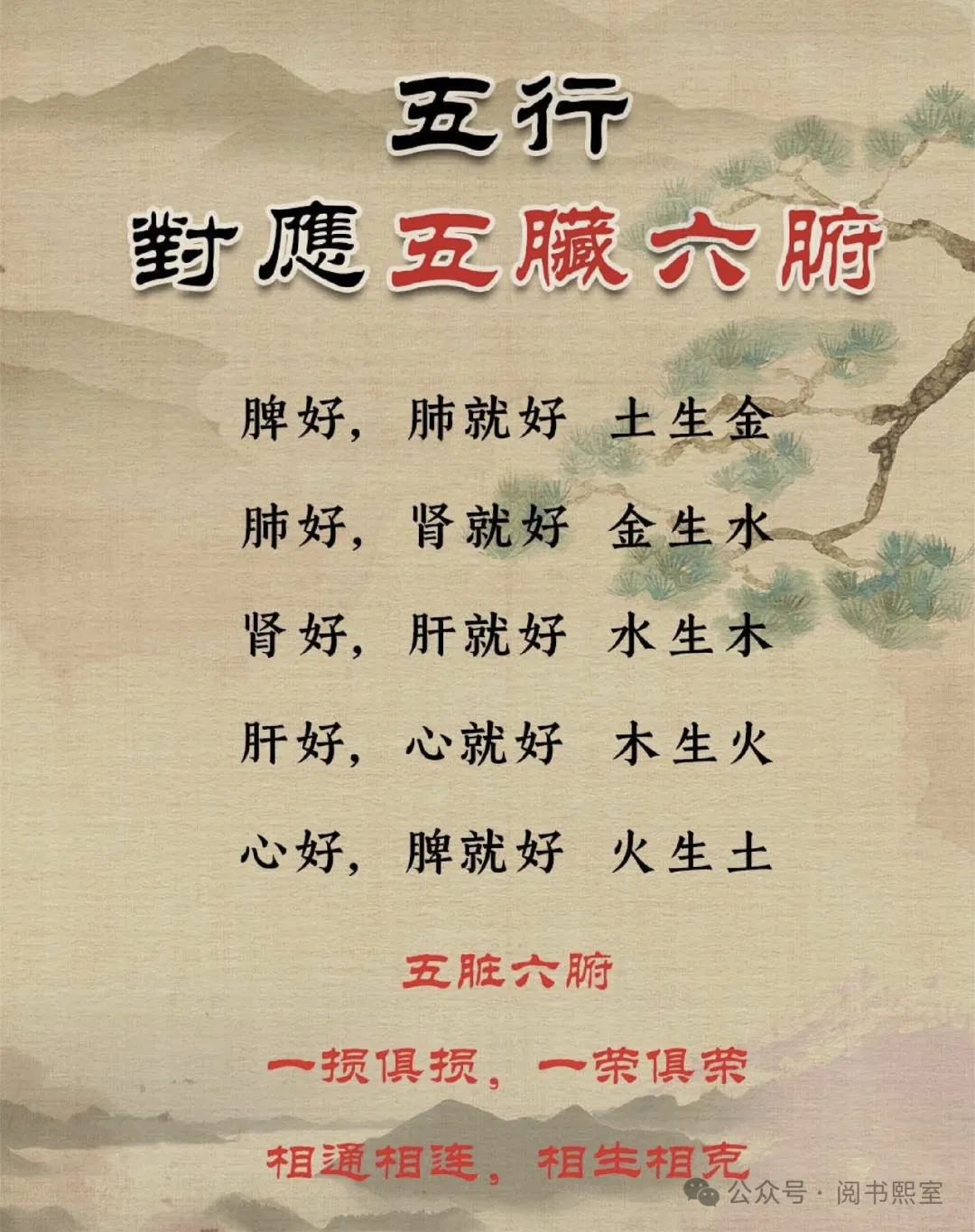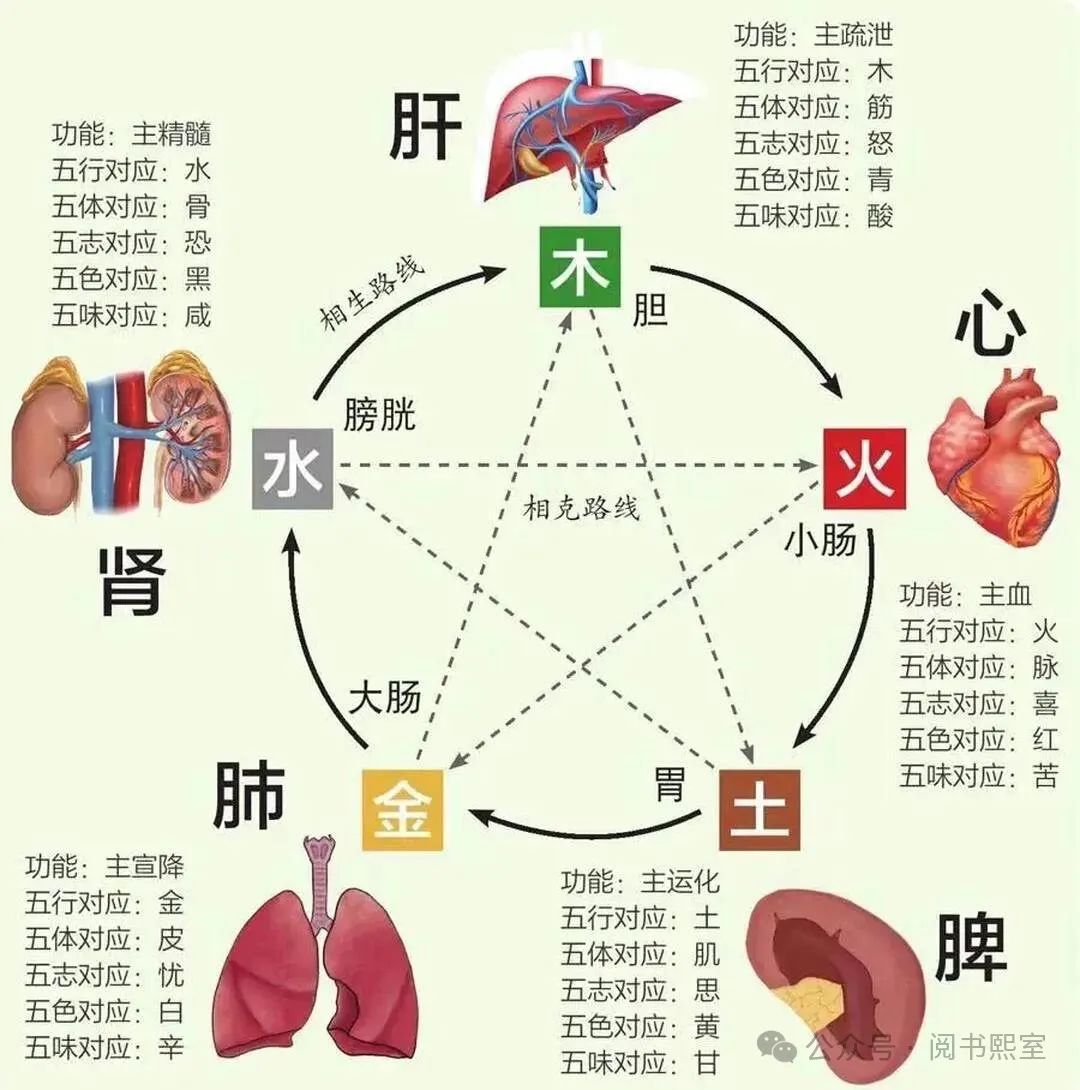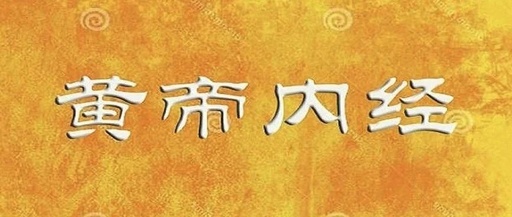
The Huangdi Neijing (黄帝内经) discusses the relationship between the Five Elements (五行) and the Five Organs (五脏) in the fourth chapter of the Jinkui Zhenyan Lun (金匮真言论篇):
Five Elements: Wood, Fire, Earth, Metal, Water
Five Organs: Liver, Heart, Spleen, Lung, Kidney
East corresponds to the color green, associated with the Liver (肝), opening to the eyes, and storing essence in the liver.
South corresponds to the color red, associated with the Heart (心), opening to the tongue, and storing essence in the heart.
Center corresponds to the color yellow, associated with the Spleen (脾), opening to the mouth, and storing essence in the spleen.
West corresponds to the color white, associated with the Lung (肺), opening to the nose, and storing essence in the lung.
North corresponds to the color black, associated with the Kidney (肾), opening to the two yin, and storing essence in the kidney.

1. The Generative and Controlling Relationships Between the Five Elements and the Five Organs
Generative relationships among the organs:
In TCM, it is said that Wood generates Fire, Fire generates Earth, Earth generates Metal, Metal generates Water, Water generates Wood. Here, “generate” implies nurturing, promoting, assisting, and supporting.
Controlling relationships among the organs:
In TCM, it is said that Wood controls Earth, Earth controls Water, Water controls Fire, Fire controls Metal, Metal controls Wood.
This manifests in the human body as:
Lung (Metal) qi clears and descends, which can suppress the Yang of the Liver (Wood), indicating Metal controls Wood;
Liver (Wood) promotes the flow, which can relieve the stagnation of the Spleen (Earth), indicating Wood controls Earth;
Spleen (Earth) transforms and transports, which can prevent the flooding of the Kidney (Water), indicating Earth controls Water;
Kidney (Water) ascends, which can prevent the excess of the Heart (Fire), indicating Water controls Fire;
Heart (Fire) Yang heat can restrict the Lung (Metal) from becoming too clear, indicating Fire controls Metal.

2. The Correspondence of the Five Tastes with the Five Elements and the Five Organs
This correspondence is used in TCM to guide dietary therapy and treatment methods. The specific correspondence is as follows: Sour corresponds to Wood, associated with the Liver.
Sour foods such as plums and pomegranates can enhance digestive function and protect the liver.
Bitter corresponds to Fire, associated with the Heart.
Bitter foods such as bitter herbs and bitter melon can clear heat, eliminate dampness, and promote diuresis.
Sweet corresponds to Earth, associated with the Spleen.
Sweet foods can nourish qi and blood, replenish energy, and relieve fatigue.
Pungent corresponds to Metal, associated with the Lung.
Pungent foods help to disperse and clear, such as scallions and ginger.
Salty corresponds to Water, associated with the Kidney.
Salty foods such as seafood and legumes can nourish and descend. Additionally, the five senses are directly linked to the five organs:
The Liver opens to the eyes, the Heart opens to the tongue,
The Spleen opens to the mouth, the Lung opens to the nose, the Kidney opens to the ears.
This indicates that the five tastes not only correspond to the five organs but also have a direct connection to the five senses, affecting the health of the body. This correspondence of the five tastes with the five elements and five organs in TCM reflects the holistic and dialectical view of TCM theory and provides a theoretical basis for dietary health.
By reasonably combining the five tastes, one can achieve the goal of harmonizing the five organs and maintaining health.

3. The Specific Correspondence Between the Five Elements and the Five Organs
The five organs refer to the internal organs of the human body, including the Heart, Liver, Spleen, Lung, and Kidney, each of which has different physiological functions and corresponding emotional activities in TCM. 1. Wood corresponds to the Liver: The liver is considered the organ of regulation and is characterized by its ability to promote and expand, similar to the growth and upward movement of wood. The Liver is paired with the Gallbladder and opens to the eyes; thus, the Gallbladder, tendons, and eyes also belong to the liver system, which falls under the category of “Wood”.
2. Fire corresponds to the Heart: The heart is responsible for circulating blood and warming the body, characterized by warmth and upward movement, similar to fire. The Heart is paired with the Small Intestine and opens to the tongue; therefore, the Small Intestine, vessels, and tongue belong to the heart system, which falls under the category of “Fire”.
3. Earth corresponds to the Spleen: The Spleen is responsible for transformation and transportation, providing nourishment to the entire body, characterized by the ability to generate and support, similar to the properties of earth. The Spleen is paired with the Stomach and opens to the mouth; thus, the Stomach, muscles, limbs, and mouth belong to the spleen system, which falls under the category of “Earth”.
4. Metal corresponds to the Lung: The Lung is responsible for respiration and dispersing and clearing, characterized by transformation and regulation, similar to the cleansing and consolidating properties of metal. The Lung is paired with the Large Intestine and opens to the nose; therefore, the Large Intestine, skin, and nose belong to the lung system, which falls under the category of “Metal”.
5. Water corresponds to the Kidney: The Kidney governs the metabolism of fluids and stores essence, characterized by nourishing and descending, similar to the moistening and nurturing properties of water. The Kidney is paired with the Bladder and opens to the ears; thus, the Bladder, bones, marrow, ears, and two yin belong to the kidney system, which falls under the category of “Water”. The pairing of the five elements and five organs not only reflects TCM’s understanding of the functions of internal organs but also guides the diagnostic and treatment processes in TCM. For example, TCM adjusts the relationships between the five tastes, five colors, and five organs to achieve health preservation and treatment goals.
 In the context of seasonal health preservation,
In the context of seasonal health preservation,
the principle of the generative relationships among the five organs becomes clearer.
For instance, according to TCM principles,
The five organs: Liver, Heart, Spleen, Lung, Kidney,
correspond to the five seasons: Spring, Summer, Late Summer, Autumn, Winter.
The five elements correspond to the five organs:
(Spring, East) Wood corresponds to the Liver,
(Summer, South) Fire corresponds to the Heart,
(Late Summer, Center) Earth corresponds to the Spleen,
(Autumn, West) Metal corresponds to the Lung,
(Winter, North) Water corresponds to the Kidney.
After spring comes summer, Wood generates Fire, meaning the Liver nourishes the Heart; if the liver blood is well-nourished in spring, the heat and excessive Yang in summer can be alleviated, and qi and blood can be balanced.
Similarly, after autumn comes winter, Metal generates Water; the clear qi of the Lung descends to support the Kidney, laying a good foundation for the storage of Yang in winter.
The theory of the Five Elements is an ancient Chinese philosophical thought, based on ancient Daoist theories, reflecting the ancient Chinese idea of the unity of heaven and humanity.
Ancient people believed that all things in the universe are composed of five basic elements: Wood, Fire, Earth, Metal, and Water, which interact and balance each other in a dynamic system.
Ancient people had a profound understanding of natural laws, and their lifestyles changed with the variations of heaven and earth; they were born from the way of heaven and earth.
As products of nature, humans correspond to various information in the natural world; recognizing and respecting this connection is the premise and foundation of human existence, and understanding natural laws and following the rhythms of heaven and earth is the highest truth of life science.
To prolong life and enjoy a peaceful old age,
the key lies in following nature and practicing health preservation.

